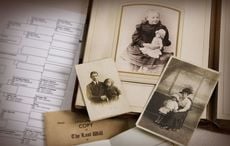I was standing in a New York City bookstore, turning the pages of an Irish photo-journal, searching for photos that would contribute to an understanding of my family’s Irish experience. Out of the corner of my eye, however, I noticed another book titled, “Weegee: Naked City.” I remembered that there was a movie and a television program called “Naked City,” both motivated by Weegee’s photos. Arthur Fellig, more commonly known as Weegee, a freelance beat reporter and photographer in the 1930s and 1940s, cruised through New York City in a 1938 Chevrolet, monitoring a police radio, racing from one event to another.
I picked up the book and turned to a picture of a transvestite in a paddy wagon and a photo of a murdered man lying under a mailbox that includes a message, “Mail early for delivery before Christmas.” The next photo left me motionless. A priest stands over two body bags, administering the last rites. An ambulance driver holds the priest’s hat and one of seven firemen pulls the drawstring on a body bag. The other firemen, framed by the night’s blackness, stand ruefully gazing at the bodies; their wet turnover coats shine with the reflection of the photographer’s flash bulb. I kept staring at the fireman to the left of the priest.
It is my grandfather Charles F. Hale.
When I was a young boy I’d to say to my father, “Grandpa’s bigger than life, right Dad?” And my father would smile when he’d hear me repeat the same phrase I’d often heard him use to describe his father.
And he truly was bigger than life. He knew everyone: Governor Rockefeller, Mayor Wagner, and Tim Mara, the owner of the New York Giants. I’d wonder? How does a fireman know all these people?
Holiday dinners with Grandpa Charlie were unforgettable. His suck-the-oxygen-out-of-the-room laugh, the slimy, half-chewed, mess of a cigar hanging from the side of his mouth, his shirt flapping in the breeze, his gravy stained tie and shouts of “How’s the turkey look, Charles?” were riotous. All that was only outdone by his incredible stories, including rescuing my grandmother from King Kong’s clutches and his “days of yesteryear”—that’s what he called them—as the Lone Ranger’s sidekick.
My grandfather had an imagination second to none, however, many years after my grandfather’s death I still didn’t have a sense of how he might have experienced his day-to-day life in the fire department. But within days of finding the “Weegee photo,” a chance event pulled me into my grandfather’s life in a way I’d never imagined. It all began in New York City on the corner of Ninth Street and Second Avenue.
I noticed an extension ladder rising to the top of the building on the northwest corner of the street. I stepped through the hoses that were strewn across the sidewalk and extended to the side of the building. A firefighter backed a line from the side door onto the street.
“What happened, a fire in the basement?” I asked.
“Nah, just a fire in the grating outside the building,” he said.
“A cigarette probably ignited some paper.”
He looked familiar, “Sal?” I said.
“Yeah.” His eyes narrowed, and he smiled. “Hey where do I know you from?”
“Charlie Hale.”
“Sure, Charlie,” he said with a big grin. “Yeah, I remember. Your grandfather, Lieutenant Hale, right?”
Sal Parisi recalled my visit to Engine Company Fourteen, located on Eighteenth Street, a year earlier. I had viewed the plaque and photo commemorating my grandfather’s service to the New York Fire Department, a pilgrimage I make every year.
“Hey, you should come by again,” he said. He pointed to a young firefighter affixing a pickax to the back of the fire truck. “Ever meet Chris Kendall?”
I hadn’t.
“He cleaned the basement and put all the old fire journals in order. They’re daily logs. They list all the runs the house makes, fires and rescues, that sort of thing.”
I was incredulous. I had no idea the journals existed. Perhaps I could uncover the story behind the Weegee photo.
“Over here,” Sal said. I followed him toward the truck.
“Hey, Chris. Say hi to Charlie Hale, Lieutenant Hale’s grandson. He’s interested in the journals.”
Chris extended his hand and flashed an easy smile. “Drop by one day, Charlie, and I’ll show you what we have,” Chris said.
Two weeks later I entered the firehouse located on East Eighteenth Street, between Broadway and Fifth Avenue. Chris Kendall emerged from behind the fire engine, a red Seagrave pumper.
“Hey, Charlie.” He wasted no time. “C’mon, I’ll grab a flashlight and we’ll go downstairs.”
Chris led me into Engine Company Fourteen’s shadowy basement. Against the far wall were standalone metal cabinets in which the old journals were neatly stacked.
Chris shone his flashlight on the journals as I knelt in front of them. I placed my hand on the worn, brown cloth-covered logs; within these journals, I thought, lay the essence of my grandfather’s day–to-day existence.
Which journals should I look through? I knew that Weegee was a staff photographer for a daily newspaper called PM Magazine from 1940 to 1945. Many of his crime and fire photos, taken in Manhattan, appeared in PM. And I knew that my grandfather was reassigned to a firehouse in Queens in mid-year 1943, so I collected three journals that covered the period from 1940 to 1943.
I picked up a journal marked 1940, opened it and held my breath as the choking odor of dust filled the air. Had anyone looked through this journal in the last seventy-five years? I pored over the pages, noting the fires my grandfather had fought, imagining his life. When I examined the 1942 journal I noted the February 9 entry. Engine Company 14 had been called to one of the most famous fires in New York City history. The luxury liner, The Normandie, which had been seized by United States government in 1940 after the fall of France, was being converted into a troop ship and ended up in flames in the Hudson River when sparks from a welding torch ignited the kapok used to store the life jackets. The journal notes that my grandfather was injured at the fire and sent to the hospital.
I focused on my original goal, the Weegee photo. How could I determine when that photo was taken? What did I know about the fire? It was dark so it occurred at night or in the early morning. The priest wore a heavy topcoat, which suggested it was wintertime. And since the fire claimed one or more lives, I surmised that the fire would have kept the company out of the house for at least an hour. I carefully examined the journals, noting the fires that fit those parameters. I found eight.
I learned that The International Center of Photography was the largest repository of Weegee photos. I called the ICP and was directed to an archivist in charge of Weegee’s work. I started with the first fire on my list. It matched my criteria. The fire occurred during a cold-weather month, March; the call came into the firehouse during darkness, 4:51 AM; the company was out of quarters for two hours and twenty-four minutes, and Firefighter Hale was one of the firefighters who responded to the alarm.
I was lucky; the archivist found the photo in a moment. The photo was published in PM Magazine on March 8, 1942.
The next day I visited the New York Public Library’s microfilm room. I requested the specific date of the PM Magazine that I wanted. I found the photo and the story on page three of the March 8, 1942, edition.
A fire had ignited—it appeared someone had fallen asleep while smoking—and the building’s occupants fled in panic. A woman, however, holding one of her children, was trapped on an upper floor. She leaped from the building with her child in her arms. They were killed on impact.
I often sit and stare at the Weegee photo and imagine the events. The photo captures the hard times and sufferings of the poor, and the immediacy of life and death. I imagine the compassion the firefighters must have felt, their feelings of helplessness and despair as the woman prepared to leap from the window with her child in her arms. I think of the men running into burning buildings, coming to the aid of people they’d never met, risking their lives to help those in need.
I often think of my grandfather, his booming life, the gravy stained tie and his stories; however, I am proudest of a eulogy written about him after he died from injuries sustained in the line of duty: “Probably no man in the history of the Fire Department did more work taking care of the widows and children of deceased Fire Fighters than Charlie Hale, and probably no other member of the Fire Department was ever more devoted to the cause of injured Fire Fighters.” The Trumpet, January 1962
The closing words from the Weegee inspired film “Naked City,” are: “There are eight million stories in the Naked City. This has been one of them.” All those many years ago I never suspected that one of them was Grandpa Charlie’s.
---
Charles R. Hale was born, raised and educated in New York. He is a former partner of a NYC based consulting firm Hale, Borenstein Ltd. Charles, along with Niamh Hyland, is a cofounder of Artists Without Walls, an organization purposed to inspire, uplift and unite people and communities of diverse cultures through the pursuit of artistic achievement. His film “Walls: We Are Not Forgotten,” about the life of singer Judy Collins, was presented at the 2012 Eugene O’Neill Award ceremony honoring Ms. Collins. In 2013 the City University of New York honored Charles for ”Outstanding Service to New York and Irish America.”




Comments